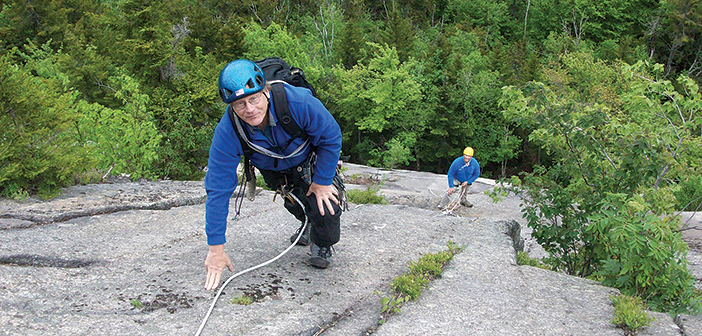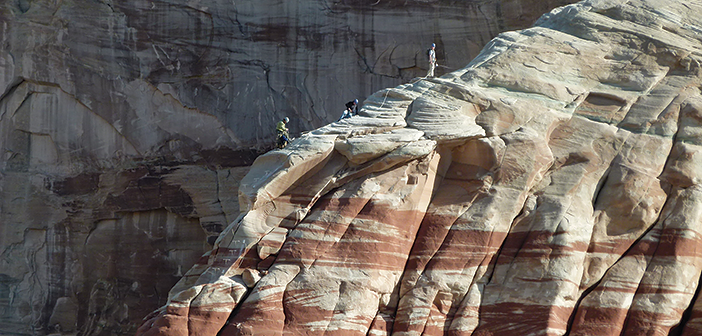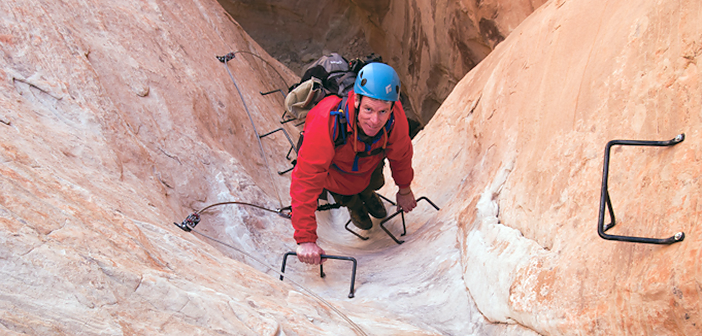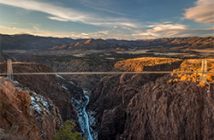The literal translation of the Italian term “via ferrata” is a bit ominous, summoning images of rigid, military marching orders. The iron way. However, today’s recreational via ferratas—essentially, assisted rock climbing routes—are a bit more inviting, and have increased in popularity as an outdoor activity at ski areas and other rocky spaces in North America.
Historically, via ferratas were true to their iron-clad name: routes composed of fixed iron cables, rungs, and suspension bridges to assist climbers scaling steep, rocky terrain. While variations on the theme date back to the 19th century, it’s generally considered that via ferratas were born during World War I to aid the movement of soldiers through mountainous regions such as Italy’s Dolomites.
Italian alpinists began restoring and expanding early military via ferratas in the mid 20th century. A real boom in recreational via ferratas arrived in the 1990s, primarily in France, where ski resorts were looking for an activity to offer to summer guests. By the mid-2000s, it’s estimated that more than 100 had been installed in Europe, with close to 200 today.
Not surprisingly, the concept migrated to North America, where a handful of recreational via ferratas now exist, most of them guided activities on traditional cable-and-rung routes.
Jackson Hole, Wyo., is jumping onto the growing trend by installing the largest known U.S.-based via ferrata complex. In the mix in the $400,000 project are two practice areas and four major routes, with a 120-foot suspension bridge included, on 500 vertical feet of rock. The site is at an elevation of nearly 10,000 feet, above the top terminal of the Bridger Gondola and the Rendezvous Lodge. Guests latch onto cables anchored to the rock, with energy absorption systems used to limit and cushion any falls. Located in the Teton range, which is renowned rock climbing terrain, via ferratas make total sense.

Jackson Hole’s via ferrata, shown under construction last fall, will have four routes spread across a 500-vertical-foot face when it opens for summer 2017. It will complement hiking, climbing, and high alpine running at the resort’s mid-mountain center of activities near the top terminus of the Bridger Gondola.
THE APPEAL
The appeal of the via ferrata concept is that it allows adventurers with no climbing experience to ascend steep, potentially dangerous routes safely, because climbers are always secured via harnesses to the fixed cable. The risk of injury or falls is miniscule. “It is adventure, but everything is safe,” says Yannick Berger-Sabattel, technical manager at Prisme, a Canadian via ferrata builder. And with the growth in popularity comes additional convenience innovations. CLiC-iT, for example, manufactures a continuous belay system designed specifically for via ferratas.
Still, the via ferrata concept is evolving and expanding. Some North American via ferrata operators apply the term to almost any safe, assisted rock climbing. They are tapping into the allure of what had been a “hot trigger word in the ’90s,” according to Chris Pearson, owner and manager of Peak Expeditions, which runs via ferrata programs in Vermont and Massachusetts.
Peak Expeditions actually uses no iron at all in its approach to the concept, and no fixed elements. Instead, it relies on “eco-friendly rope systems.” Its Vermont location, for example, employs horizontal Tyrolean traverses, rope bridges, rappelling, and other rope techniques. Compared with a full-fledged via ferrata, a rope system comes at a fraction of the cost. And with no fixed elements left behind on rocks or trees, permitting is usually a relative breeze.
Bretton Woods in New Hampshire has taken an intermediate approach, installing fixed steel bolts on a 400-vertical-foot series of slabs on the north face of Mt. Oscar, providing anchors for rope-assisted climbing. It is an experience that the resort’s climbing program director Steve Nichipor calls “via ferrata inspired”—a safe ascent up a near-vertical face for novice rock climbers.

Via ferratas typically involve drilling metal anchors and rungs into rock faces to create assisted rock climbing routes. Photo: Adventure Partners
Bretton Woods recognizes that climbing, via ferrata-assisted or otherwise, is not likely to appeal to the great majority of its guests. Hence, it has kept its via ferrata program relatively small. The resort maintains a three-person-per-guide ratio, with three guides and two tours a day.

The West Wall Climb at Bretton Woods Resort, N.H., is part of its “via ferrata inspired” climbing program.
There are several other considerations aside from the materials used. Via ferratas can be expensive to install and, depending on where they are being installed (federal, state, or private land), they can be subject to rigorous permitting and regulation. They also can’t be installed just anywhere. You need extended, vertical rock; some classic via ferratas in the Dolomites cover more than 3,000 vertical feet, but 400 vertical feet is a good starting number. That rules out flatland locales (although Mike Friedman, managing partner at Adventure Partners, a via ferrata builder, says that installing a route on a city building might be possible, even if it has yet to be tried anywhere in the world).
BUT WHY?
Adventure seekers today have a choice of gravity assisted options—zip lines, downhill mountain biking, water-park slides, and more. Why would someone pay to hang off of a vertical face, doing battle with gravity and often (depending on the length and complexity of the via ferrata) spending more than three hours doing so?
Via ferratas are a decidedly niche activity and don’t necessarily aim to capture the potential client base of a zip line or a canopy tour. Consider the via ferratas that Adventure Partners has installed on sandstone towers at Amangiri, an ultra-high-end resort in southern Utah. According to Friedman, the resort’s 8,000 annual guests sign up for only about 400 guided climbs. That’s just 5 percent.

he via ferrata at Amangiri, Utah, allows non-technical climbers to experience an extraordinary landscape up close and personal.
One reason for the relatively low numbers is logistical. Pearson says that Peak Expeditions abides by a six-to-one client-to-guide ratio, so with three guides, that maxes out to 18 guests for a two-or-more-hour period. At via ferratas in Quebec, says Berger-Sabattel, guest numbers top out somewhere around 100 a day, still relatively small.
Another limitation is that, while most via ferratas are not exceptionally demanding physically, they still require a certain degree of fitness. A rule of thumb, says Berger-Sabattel, is that “if you are able to climb a ladder, you can climb a via ferrata.” Simple enough for most people, but certainly not for everybody. Nichipor sets an age range of about seven to 70, but that might be optimistic, with the length and complexity of a route obviously being major determining factors.
Some, however, come away with a reward far different from the quick adrenal rush of a zip line or the communion with nature of a canopy tour. The reward of a via ferrata is perhaps more introspective, a sense of accomplishment that comes with conquering the fear of heights or, as Friedman puts it, coming to grips with “the exposed positions you encounter on a rock climb.”
If guest numbers are relatively small, so, for the most part, are the costs. According to Alexa Bernotavicz, Bretton Woods assistant director of ski operations, the resort’s via ferrata-inspired installation cost less than $5,000. But install costs can vary dramatically. Friedman says that a via ferrata that Adventure Partners’ Jackson Hole installation will cost around $400,000, inflated by the high cost of helicopter assistance. Berger-Sabattel throws out an average figure of C$600 per meter.
Once installation is complete, operating costs are relatively low, with big-ticket line items being guide salaries and carabiners, ropes, harnesses, and energy absorbing systems to cushion falls. The latter need to be replaced from time to time, but the fixed via ferrata components are essentially maintenance-free.
THE PAY OFF PAYOFF
Can a via ferrata be a profit center? Operators need first to determine how a via ferrata might fit into their overall activity mix. At a place like Bretton Woods, says Bernotavicz, or at Amangiri, the main goal is to have something different to offer summer guests. Within that context, marginal profitability—or perhaps no profit at all—might be acceptable, if it attracts more room bookings through the offering of a comprehensive activities package.
Pricing can also be a limiting factor. Because via ferratas are a relatively new activity in North America, no standard price range has been established. Per-person ticket costs vary widely, from less than $50 to as much as $400, although $80 to $100 seems a common number.
Berger-Sabattel estimates that the via ferratas his company has installed in Canada yield a return on investment in a three- to four-year range. He says the possibility of combining a via ferrata with other activities increases appeal. At Parc des Chutes Coulonges in Quebec, for example, a short via ferrata has been combined with a zip line for the post-climb descent.
Although via ferratas have a very good safety record, the cost of liability insurance remains unclear. Part of that is due to the fact that via-ferrata-specific safety standards, from guide certification to equipment standards (size of the cables, weight-bearing capacity of rungs and anchors, etc.) haven’t been established. Bernotavicz says that the Bretton Woods via ferrata is covered under the resort’s umbrella liability package.

Mt. Norquay’s three via ferratas overlook Banff, Alberta’s spectacular Canadian Rockies. The longest route stretches more than 2 kilometers (nearly 1.5 miles).
Because of the inherently smaller participation numbers when compared with other adventure activities, via ferratas are not likely to be big revenue generators in a stand-alone context. Still, Friedman is optimistic about “a huge short-term growth potential, especially at ski areas.”
What Friedman likes is that this is an activity that fills out an overall adventure offering, providing a more physical (and for some, mental) challenge than other activities. Unlike a zip line, “you don’t just shove off and scream,” he says. “It is an earned experience.”
VIA FERRATA SUPPLIERS
Adventure Partners
(970) 596-4025
Mike Friedman
[email protected]Prisme
(450) 973-2226
Yannick Berger-Sabattel
[email protected]Tree-Mendous
(518) 288-2920
Gerhard Komenda
[email protected]Aerial Adventure Tech
(828) 264-0751
Alicia Green
[email protected]Clic-iT
(571) 732-5291
Philip McCharen
[email protected]






